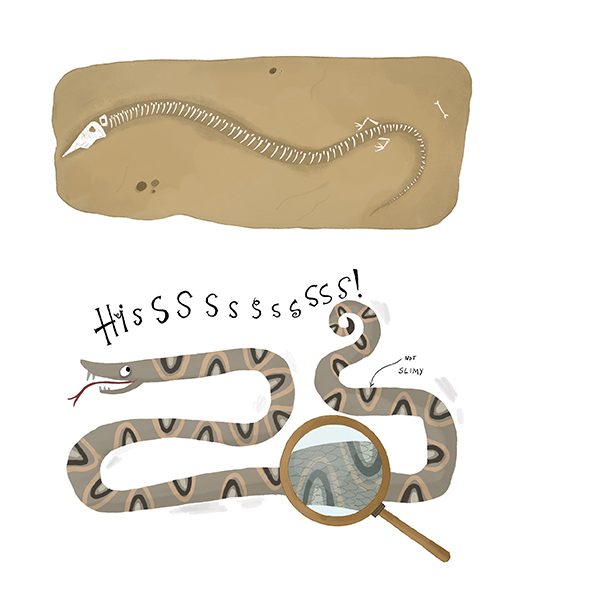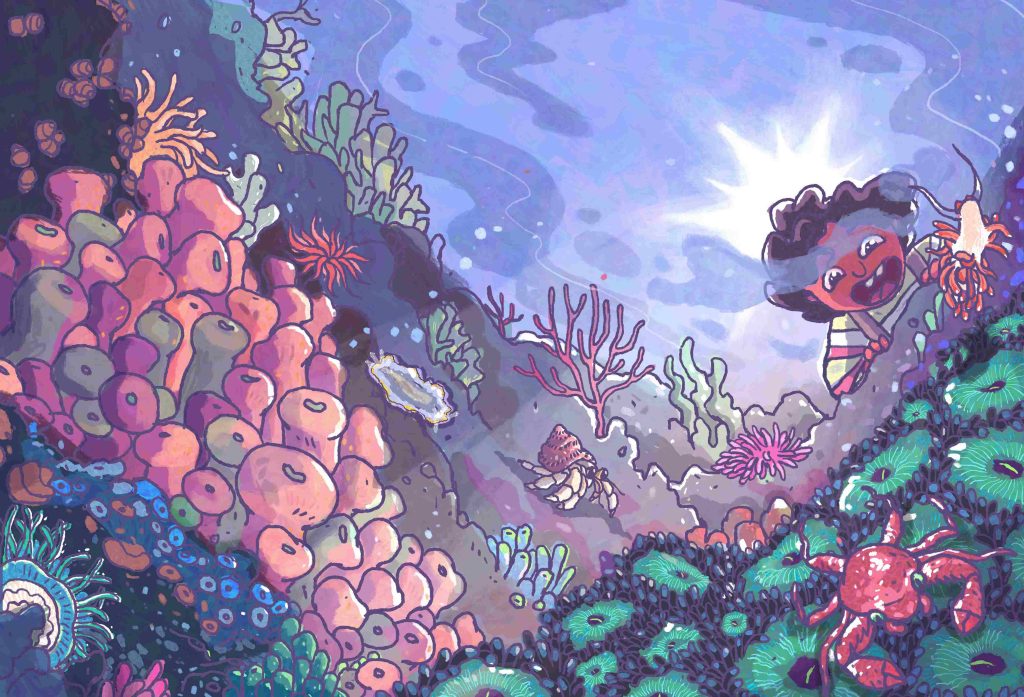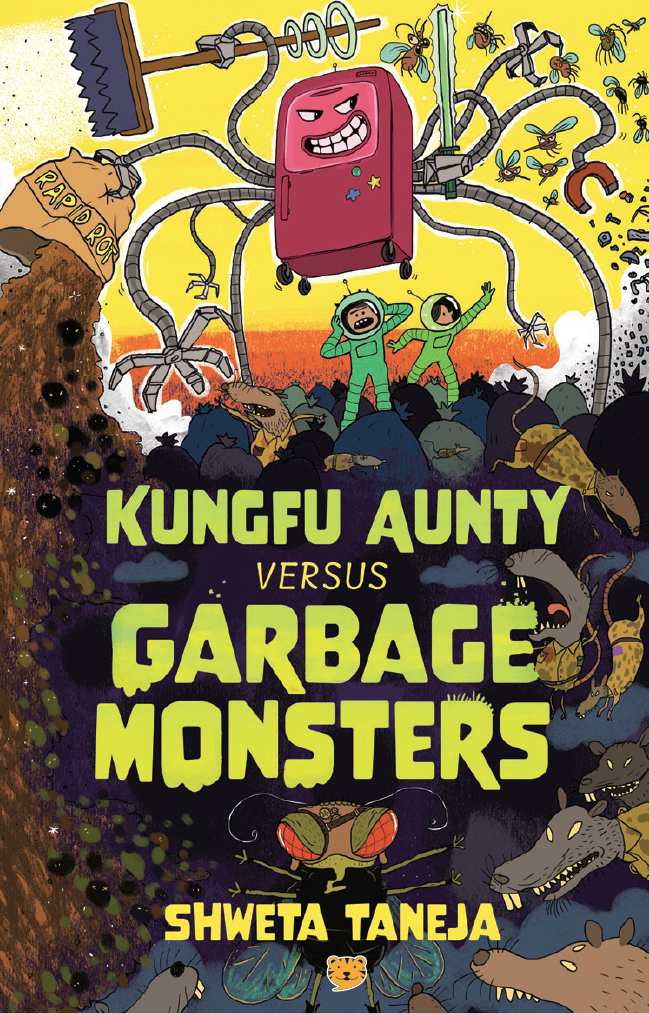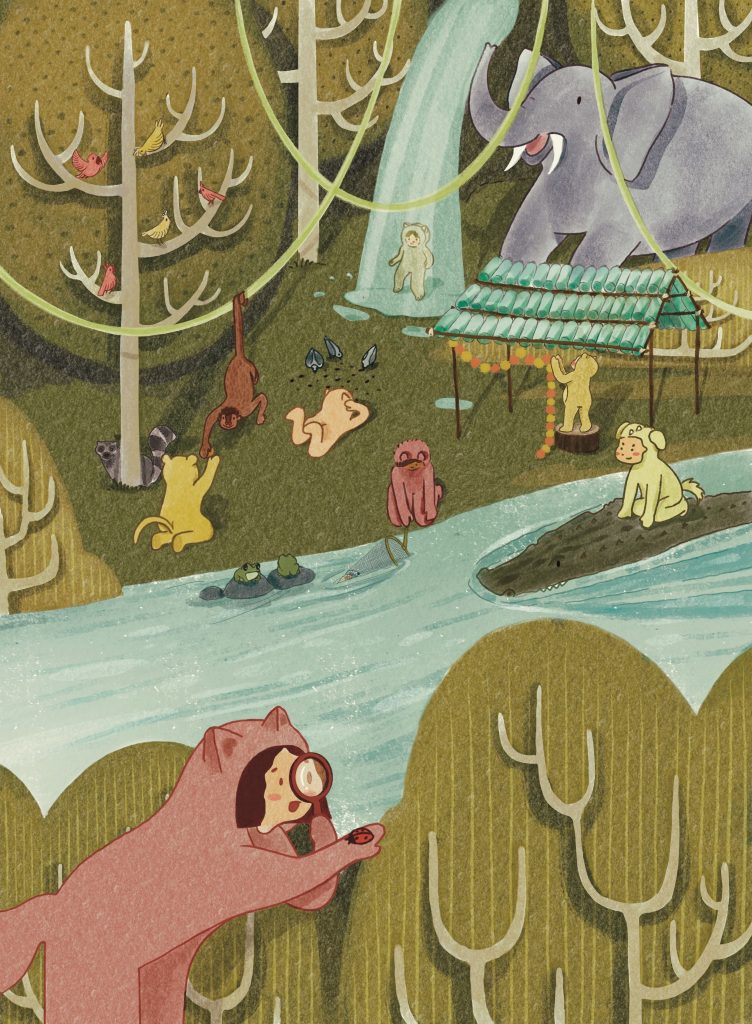Have you ever seen a snake while you were out walking? Or maybe at the zoo? How did it make you feel? If you were scared, you’re not alone! Many people are convinced that they were born afraid of snakes. However, some scientists don’t believe that is the case—they think that we may learn to fear snakes when we are young partly because we are so good at detecting them. Read on to find out more!
Why might we fear snakes?
Everyone knows what a snake looks like: long, scaly body with no arms or legs, a distinct and sometimes pointy head. Our brains can pick out the long, sleek shape of a snake quicker than it can detect the shape of a mouse or a grasshopper because we know that the snake is a bigger threat. Think about a time where you may have mistaken a rope or stick for a snake and spooked yourself! This happens because we are really good at picking out shapes that could be harmful to us.
Our brains are masters of recognition. We can see shapes in clouds, words in word searches, and even faces in household objects! So it comes as no surprise that we can quickly recognise snakes and their movement. Long ago, our ancestors had to live beside snakes every day. Snakes can be dangerous if they are frightened, and venomous snakes posed a big problem for the first humans. The brain figured out a way to keep us safe from snakes by learning how to recognise their shape and the way they move, faster than we identify other animals and movements. This quick perception made us more prepared to learn to fear snakes.
But are humans scared of snakes from the time we are born? It turns out that babies are not scared of snakes, but they are very good at identifying them quickly and focusing on them. Researchers showed babies under six months old pictures of different animals and plants and noted their reactions. Though the babies showed increased focus and heightened awareness when viewing the snake picture, they did not seem afraid of the photo until they were shown a picture of a scared adult face next to it. This could mean that the babies only acted afraid of the snake when they saw another person who was scared. We can learn to be afraid of things like snakes and spiders by watching how other people react to them, or by having a negative experience with these animals.

We might also confuse being startled with being afraid. When you are startled by something, like when your friend jumps out from behind a door, you aren’t afraid of them—you’re just spooked for a second! That is similar to the way we feel when we first see a snake because we are quick to detect them. We jump because we see something that we weren’t expecting to, and we need to be prepared to protect ourselves. When we realise what spooked us, we either relax if it is something silly, or feel fear if it is something that we think could hurt us. The fear we feel after detecting a snake could be a reaction that we learned. Scientists think we might fear snakes partly because of how they are portrayed on TV or in books and magazines. Snakes are often “vilified”, which means that people make them seem scarier and meaner than they actually are.
Remember what I mentioned earlier about our brains being good at recognising snakes? This trait makes our brains more prepared to be afraid of snakes. We make the connections in our mind that make us relate how quickly we react to snakes with the possible danger they present. We are more likely to learn to be scared of things that can hurt us. When we learn from movies, books, or even other people that snakes are scary or dangerous, it’s easier for us to learn to be afraid of them.
Should you be afraid of snakes?
Since it was most important for our ancestors to avoid venomous snakes (those that deliver a harmful substance through their bite or sting—as opposed to poisonous animals, which are those that make others sick when eaten or touched) that could make them very sick, we might jump to the conclusion that any snake we see is venomous, and therefore dangerous. Venomous snakes can be found all over the world. Snakes with venom use it to immobilise their prey—or make it still enough to eat.

Venomous snakes can use their venom to protect themselves, too. Many times, when a venomous snake bites a human, it is because the snake was startled or was being handled by the human. Luckily for us, snakes do not usually bite unless they are threatened and have to protect themselves. Most scaly serpents prefer to slither away when something bigger than themselves comes near. This means that most of the time snakes aren’t going to chase you or even come near you. We’re also much larger than snakes’ normal prey, and they know that, too. So have no fear—there’s no way a snake will mistake you for a meal (unless maybe you smell like a mouse).
Even if you aren’t afraid of snakes, you may find them creepy! You are not alone in feeling this way. Maybe you think snakes are slimy. Or maybe the way they move and their lack of legs weird you out. We tend to not like animals that look very different from us compared to animals that are more familiar. Animals with four legs and fur are easier for us to relate to and form bonds with; snakes are neither furry nor four-legged, so we might find them too bizarre to like.
However, snakes may be more like humans than you think! Snake ancestors long ago once had legs, and some snakes have little pieces of those old legs hidden in their bodies. Snake scales are even made of the same material that our nails are made of: keratin. Though they are scaly, snakes are neither slimy nor wet! Their shiny scales give the appearance of sliminess, but they are actually dry and smooth. If you want to know what a snake feels like, rub your fingernail!

Why should we like snakes?
Sometimes people want to harm things that they find gross or scary. Snakes are often harmed by fearful people for this same reason. It is important to respect snakes and protect them, though. Snakes are a crucial part of many ecosystems because not only do they eat other, smaller animals, but they are food to bigger animals as well. We can even benefit from snakes. Pesky mice and insects that creep into our homes can be kept at bay by a hungry snake in your backyard. Snakes are more helpful than harmful!
So, are you born with a fear of snakes?
Probably not, but that doesn’t mean that we aren’t born with a readiness to be afraid of things that can hurt us. We know that our brains evolved to distinguish a snake in the grass more quickly than other creatures, and that happened because venomous snakes can be dangerous to humans when provoked or startled. We may learn through TV shows and books that snakes are scary, but we aren’t born being afraid of them. We are born with an excellent ability to recognise the potential danger snakes pose. So thank your brain for its excellent recognition skills and admire our legless friends from a distance!






